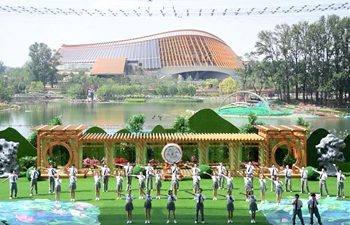BEIJING, June 7 (Xinhua) -- When pet bird keepers in Beijing take a stroll in the hutongs, the city's labyrinth of traditional alleys, they often hang their bird cages on the branches of a tree or the protruding parts of a wall during breaks.
In the eyes of Japanese architect Shuhei Aoyama, this common act not only is a smart utilization of public space but also has an artistic meaning, representing a person's move to "establish a link with the city."
Shuhei, who lived in the hutongs for 10 years after moving to Beijing in 2005, sees the historical blocks of narrow alleys as both a long-time subject of his works and an endless source of inspiration for his architectural career.
In his latest renovation project of an old hutong, Shuhei rebuilt a traditional courtyard by blending new, modern materials with recycled old window frames and gray bricks.
"The old objects were endowed with new functions. Through them, we can catch a glimpse of life in a bygone era," he said. "It's like establishing a link between the past and the future."
One thing Shuhei loved about living in the hutongs is the fluid boundaries between people's living space and the surrounding environment.
In the summertime, Shuhei enjoyed the coolness in the courtyard as leafy trees kept strong sunshine at bay. During the winter, he found the rooms cozily illuminated by light coming through leafless branches.
"Living in the hutongs offers you the unique experience of feeling the cycle of nature year in and year out," Shuhei said.
In many projects concerning rebuilding old neighborhoods, Shuhei added the design of skylights into his work, an idea inspired by the wide-open vertical view from a traditional courtyard.
"After you install a skylight in a single-story building, the sky view is exclusively yours," said Shuhei. "You can enjoy the view of the sky and the trees, as well as the sunshine that showers down."
During his time spent in the hutongs, Shuhei often saw with great intrigue that neighbors move rarely used furniture to the shared space of the neighborhood, some of which later became a public belonging.
"They did so because they believed the shared space is also part of their home," said Shuhei. "In their mind, the whole hutong is their home."
This concept inspired Shuhei to break the stereotypes of a home by exploring the possibilities of shared living spaces. In some apartment projects, he treated shared spaces, such as cafes and gyms, as an extension of the home.
With his projects that draw heavily on elements of the hutong, Shuhei has renewed people's interest in, and broaden their understanding of, the traditional alleys.
"The hutongs are by no means out of date," said Shuhei. "Incorporating them into our modern living is also a form of protection and conservation."

















